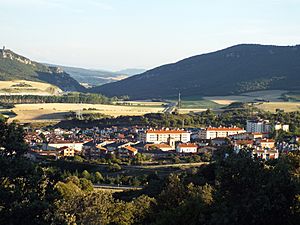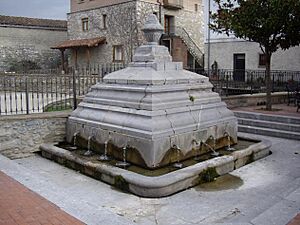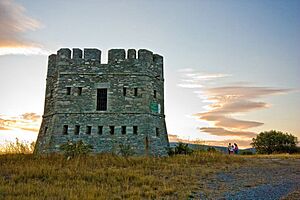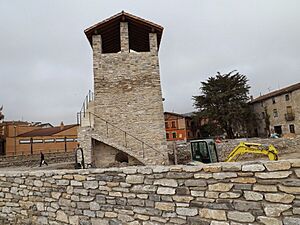Nanclares de la Oca facts for kids
Quick facts for kids
Nanclares de la Oca / Langraiz Oka
Nanclares de la Oca / Langraiz Oka
|
||
|---|---|---|
|
Village
|
||
 |
||
|
||
| Country | ||
| Autonomous community | ||
| Province | Araba/Álava | |
| Kuadrilla / Cuadrilla | Añana | |
| Area | ||
| • Total | 21.03 km2 (8.12 sq mi) | |
| Elevation | 501 m (1,644 ft) | |
| Population
(2014)
|
||
| • Total | 2,281 | |
| • Density | 108.46/km2 (280.92/sq mi) | |
| Demonym(s) | nanclarino, -na langraiztarra |
|
| Time zone | UTC+1 (CET) | |
| • Summer (DST) | UTC+2 (CEST) | |
| Postal code |
01230
|
|
| Official language(s) | Spanish, Basque | |
Nanclares de la Oca (or Langraiz Oka in Basque) is a village in Spain. It's found in the Álava province, which is part of the Basque Country. This village is the main town of the Iruña de Oca area. It is also the biggest village in the Cuadrilla de Añana region.
Before 1976, Nanclares de la Oca was its own separate area. It included the villages of Montevite and Ollávarre. The village is in the western part of the Llanada Alavesa, which means the plains of Álava. It's only about 12 kilometers from Vitoria-Gasteiz, the capital city of the Basque Country.
Contents
Exploring Nanclares de la Oca's Past
Early People and Roman Times
The first mention of Nanclares de la Oca was found on an old stone tablet. This tablet was made by the Celtiberians, an ancient group of people. It called the town "Langrares". This makes experts think that people lived here even before the Romans arrived.
Roman ruins have been found nearby in Iruña-Veleia, an ancient city. More recently, Roman remains were also found in Nanclares itself. When the Romans came, life changed a lot. Iruña Veleia and its surrounding areas became very important places.
The Middle Ages in Nanclares
We know that Templar knights had settlements here during the Middle Ages. Some people think the name "Oca" might be linked to the Templars. They supposedly called their living area "Tierra de la Oca", meaning "The Land of Geese". However, the exact reason for the name isn't fully known.
Nanclares de la Oca is listed in an old book from 1025. This book is called the Reja de San Millán. In this book, the village is called Alfoces Langrares. In the Middle Ages, an alfoz was a territory that belonged to a main town. It was divided into smaller areas called councils. Langrares was one of these councils.
From the 1800s to the 1900s
During the Spanish Independence War, many English soldiers were near the village. This was especially true during the Battle of Vitoria. These soldiers were led by Wellington. Their job was to wait in Nanclares de la Oca. They would cross the Zadorra river and attack the enemy after other troops had secured the area.
The Carlist Wars also happened in Nanclares. Because of these wars, there are now three small castles nearby. They are called Almoreta, Vayagüen, and El Encinal.
In the late 1800s, a special health spa called Bolen or Bolem was built. It became very popular and was even considered one of the best in Europe. But by the end of the century, the spa closed down. Later, in 1914, a group called La Mennais Brothers moved in. They fixed up the old spa building. They turned it into a school where future Brothers were trained. Today, this building is a Secondary School called Colegio San José de Educación Secundaria Obligatoria.
Nanclares in the 20th and 21st Centuries
In the 1900s, the town grew a lot. More people moved there, and the village expanded in size.
During the Spanish Civil War, a large building was used to hold people. After the war, it was changed and became a place where people were kept. In the early 1980s, this building was updated and became a prison.
In 2011, a new, much larger prison was built on San Miguel mountain. This modern facility was made to replace the older one.
How Many People Live Here?
The first official count of people in Nanclares was in 1802. At that time, only 47 people lived there. Later counts showed more growth:
- 1960: 1,164 people
- 1970: 1,369 people
- 1978: 1,531 people
- 1981: 1,345 people
Since the year 2000, a count has been done every year. You can see how the population has grown in the table below.
| 2000 | 2001 | 2002 | 2003 | 2004 | 2005 | 2006 | 2007 | 2008 | 2009 | 2010 | 2011 | 2012 | 2013 | 2014 | 2015 |
|---|---|---|---|---|---|---|---|---|---|---|---|---|---|---|---|
| 1,292 | 1,350 | 1,419 | 1,456 | 1,500 | 1,593 | 1,718 | 1,807 | 1,999 | 2,093 | 2,161 | 2,163 | 2,249 | 2,278 | 2,281 | 2,337 |
Fun Places to Visit
Herriko Enparantza (Town Square)
This square is in the very center of Nanclares. Its main feature is the "Fuente de los 12 caños" (Fountain of the 12 Spouts). This fountain was built in 1901. You can also see an old wash-house nearby.
From the square, you can spot a small stone bridge. A stream called El Torco flows under it. In winter, this stream turns into a beautiful waterfall.
The Three Castles
These three small towers were built in the 1800s. They were used by soldiers during the Carlist Wars. Their purpose was to guard the area, send messages, and defend the town. They are named Vayagüen, Almoreta, and El Encinal.
- Vayagüen: This is the biggest tower in Nanclares. It covers an area of 115 square meters and is 7.5 meters tall. It was used to send messages using light signals, like an old-fashioned telegraph. You can find it in the east, across from the old prison.
- Almoreta: This small castle is in the southern part of town, past the train tracks. It's the smallest tower, only 70 square meters. It was used both for sending messages and as a fort. Today, it's a youth hostel where young people can stay.
- El Encinal: This tower is located in the Badaia Mountains, north of the town. It covers an area of 94 square meters.
El Calero (The Lime Kiln)
El Calero was a special oven built in 1850. It was used to make lime from stones. This oven was very tall, about 15 meters high. It was a "non-stop" oven. This meant new stones could be put in the top while the ones at the bottom were being heated.
The stones were heated to a very high temperature, around 1000°C. The whole process took about a week. In 2013, El Calero was rebuilt. Now, people can visit it and learn how it worked.
See also
 In Spanish: Nanclares de la Oca para niños
In Spanish: Nanclares de la Oca para niños






